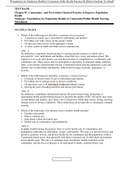Summary
Grade 12 IEB Life Science Strand 2 COMPLETE summary: Endocrine system, Reproduction, Strategies
- Course
- Life Sciences
- Institution
- 12th Grade
I know how overwhelming it is to stare at a thick pile of notes and not know where to start. Well, start here. I condensed all of strand 2 into just a few pages (without leaving out any important information). These notes helped me achieve 95% in Life Science for matric and I hope they'll help you ...
[Show more]










